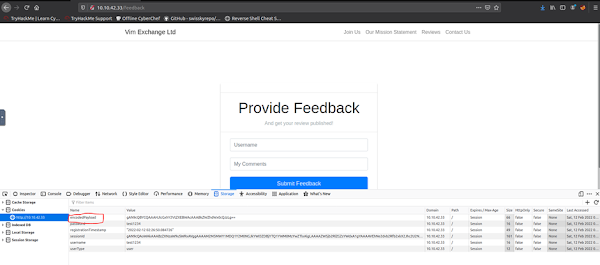Hi all, In this series I am not covering all the TOP 10 but I am planning to cover the difficult and new ones at this point but soon I will also have a blog on the most popular ones too. Lets start than
Insecure Deserialization is a vulnerability which occurs when untrusted data is used to abuse the logic of an application. Simply, insecure deserialization is replacing data processed by an application with malicious code; allowing anything from DoS (Denial of Service) to RCE (Remote Code Execution) that the attacker can use to gain a foothold in a penetration testing scenario.
Ultimately, any application that
stores or fetches data where there are no validations or integrity checks in
place for the data queried or retained. A few examples of applications of this
nature are:
·
E-Commerce Sites
·
Forums
·
API's
·
Application Runtimes (Tomcat,
Jenkins, Jboss, etc)
A prominent element of object-oriented programming (OOP), objects are made up of two things:
- State
- Behaviour
Simply, objects allow you to create similar lines of code without having to do the legwork of writing the same lines of code again.
For example, a lamp would be a good object. Lamps can have different types of bulbs, this would be their state, as well as being on/off - their behaviour!
Rather than having to accommodate every type of bulb and whether that specific lamp is on or off, you can use methods to simply alter the state and behaviour of the lamp.
What Does Serialization and Deserialization mean?
Serialisation is the process of converting objects used in
programming into simpler, compatible formatting for transmitting between
systems or networks for further processing or storage.
Let’s consider an example to understand the process.
Say you have a password of "password123" from a program that needs to be stored in a database on another system. To travel across a network this string/output needs to be converted to binary. Of course, the password needs to be stored as "password123" and not its binary notation. Once this reaches the database, it is converted or deserialized back into "password123" so it can be stored.
Simply, insecure deserialization
occurs when data from an untrusted party/user gets executed because there is no
filtering or input validation; the system assumes that the data is trustworthy
and will execute it no holds barred.
Step 2: A demo account is created and after the
creation of the demo account we do check what data is present in the cookies
present by using inspect element.
Step 3: After Inspecting the cookie values, we were
able to see that the user sensitive data is provided in the cookie values. The
session ID data that is provided is a base 64 data which will provide the First
flag. The “userType” cookie help us to know what kind of the user
permissions are provided for the user to access the application.
What if we can change the user
to be an admin of the application? Let’s try to be an admin.
Step 5: Let’s Try performing a more Nefarious attack
than just changing the cookies to know about the infamous Insecure
Deserialization attack. Now change the “userType” cookie value and traverse to /myprofile
page and access the “Exchange your vim” module.
Step 6: After this click on “Provide your feedback!” and you are redirected to a form. Where any comments can be written. Now let’s understand the situation and try to think what makes this feature vulnerable.
When we click on the “Exchange your vim” option a cookie is encoded and stored in the browser which is perfect for us to modify. And when we click on the feedback form the cookie data is decoded then deserialized. This Vulnerability exploits Python Pickle. A link to understand this issue is provided in the end of the blog.
Now let’s start exploiting this feature to get RCE on the server.
Step 7: Because the code being deserialized is from a base64 format, we cannot just simply spawn a reverse shell. We must encode our own commands in base64 so that the malicious code will be executed.
From the code above we can
see that a reverse shell is created, and the IP of the system where the VPN is
running is provided and the PORT where we can listen is provided. And after
this the malicious code is converted into the base 64 data
Step 8: Initiate netcat and start listening on port 4444.
Copy the Highlighted payload and paste it into the “encodedPayload” cookie data and refresh the webpage.
Step 9: We can see on the netcat tab that we have received a connection on the port 4444. By using it we were able to fetch the flag.
- Implementing integrity checks such as digital signatures
on any serialized objects to prevent hostile object creation or data
tampering.
- Enforcing strict type constraints during deserialization
before object creation as the code typically expects a definable set of
classes. Bypasses to this technique have been demonstrated, so reliance
solely on this is not advisable.
- Isolating and running code that deserializes in low
privilege environments when possible.
- Logging deserialization exceptions and failures, such as
where the incoming type is not the expected type, or the deserialization
throws exceptions.
- Restricting or monitoring incoming and outgoing network
connectivity from containers or servers that deserialize.
- Monitoring deserialization, alerting if a user
deserializes constantly.














